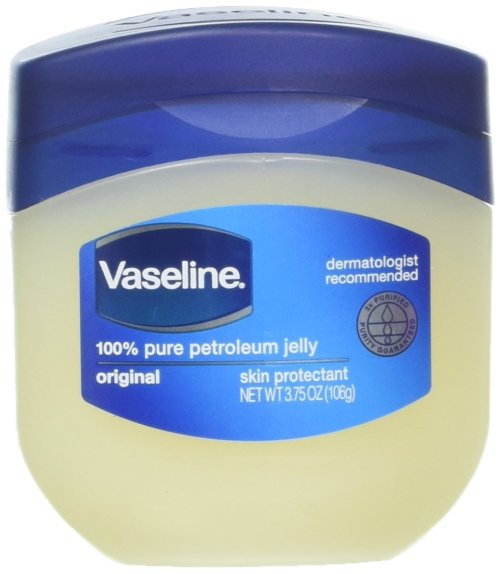Our editors independently select these products. Making a purchase through our links may earn Well+Good a commission
The best skin-moisturizing ingredient might be the one your mother, grandmother, and great-grandmother have known about all along. It only costs $7 to add it to your own collection (if it’s not a part of it already). Petroleum jelly, most well-known under the brand name Vaseline, has many uses, from soothing dry skin to helping style eyebrows. Before you use Vaseline as a moisturizer, however, there’s some things you should know about its properties and the way it interacts with your skin.
Experts in This Article
dermatologist and founder of SLMD Skincare
internal medicine doctor and founder of Skin by Dr. Simran Sethi
board-certified dermatologist and pediatrician at SkinSafe Dermatology and Skin Care in Beverly Hills, California
Is Vaseline (aka petroleum jelly) really good for your skin?
Petroleum jelly has gotten a bad rap in the clean beauty revolution because it starts out as a petroleum by-product; however it’s highly refined and totally safe (and frequently recommended by dermatologists) to use, particularly for those with dry skin. “Petroleum jelly is very occlusive, meaning it works to keep moisture from leaving your skin by blocking exposure of the skin to air, because dryness in the air can really pull moisture from your skin,” says dermatologist Sandra Lee, MD, aka Dr. Pimple Popper and the founder of SLMD Skincare. “In some ways, that’s wonderful, as this type of thick formula can strengthen the skin’s barrier, making it less likely for water to evaporate from your skin and dry it out. However, this isn’t true for all skin types.”
Want to know more about the all-star ingredient, and the wide variety of Vaseline uses for skin? Keep scrolling.

Vaseline 100% Pure Petroleum Jelly — $7.00
Benefits of Using Vaseline (aka Petroleum Jelly)
1. It helps lock in moisture in
Petroleum jelly is thick like peanut butter, so it’s not necessarily something you’ll want to slather all over your body like lotion, but it’s a great choice for areas like the elbows, knuckles, and lips that are dry or prone to dryness, says Dr. Lee. “In the winter, many of us need to switch to more moisturizing products, so it’s common to increase the use of petroleum jelly during winter months,” she says. “Personally, I have very dry skin, so I can tolerate a thin layer of petroleum jelly under makeup, but someone with really oily skin would probably hate this. It’s definitely a greasier product that can make applying makeup or other skin-care products a little more difficult.”
2. It helps with cuts and scrapes
Dr. Lee suggests using petroleum jelly to moisturize your dry heels, the cracks or fissures around your fingertips, and the split corners of your mouth before you go to sleep. It helps with these things because it not only can help prevent painful splitting in the skin, but it also helps keep those areas moist, and it’s safe to use almost anywhere on your body.
“This non-irritating, barrier-sealing product is a great option for preventing chapped lips, soothing irritated skin, and even treating skin clean wounds,” board-certified dermatologist Tsippora Shainhouse, MD, previously told Well+Good.“With no potential for skin allergy, it protects the skin by creating an artificial, and protective, skin barrier that holds in moisture, allowing the skin to heal.”
3. You can use it in your makeup routine
Ever heard of soap brows, wherein you use a bar of soap as a way to slick your arches to your face? Welp, we’ll do you one better. By dabbing on a petroleum jelly product on arches, you can help style your brows without the threat of skin irritation.
And, bonus points: Simran Sethi, MD, medical director of RenewMD Beauty & Wellness and founder of Skin by Dr. Simran Sethi, says petroleum jelly can also be used as an eye makeup remover. However, there’s a caveat. She says using a cleanser or some type of restorative skincare product after is a must for replenishing long-term moisture to the skin.
4. It acts as a dry skin spot treatment
As previously stated, while you likely don’t want to cover yourself from head-to-toes in Vaseline, it can act as an A-plus spot treatment for those with dry skin. “You can use petroleum jelly on your elbows, knees, and anywhere else you experience extra dry skin. It’s also wonderful if you have eczema, as it can help alleviate and control related flare-ups,” says Dr. Lee.
That said, Dr. Sethi notes that Vaseline doesn’t necessarily get rid of dry skin. It simply creates a skin barrier. “Vaseline can not and does not provide hydration because hydration can only be developed, replenished, and retained when the skincare contains medical-grade ingredients that are able to absorb and penetrate from the skin barrier (epidermis) into the skin’s dermis, where all skin renewal takes place,” she says. In other words, you still need a good moisturizer in your skincare routine.
How To Use Vaseline on Your Skin
So you’ve decided to apply petroleum jelly to your skin— great! Here’s how to do it the right way.
- 1.Select a product like Vaseline or Aquaphor.
- 2.Assess the area that you’re trying to treat. If it’s a bigger surface area, you’ll need more product than if you’re treating a smaller area like your lips. Remember: A little bit goes a long way and you want the skin to feel ever so slightly shellacked and not like you have on globs of PJ.
- 3.Using a cotton swab or some kind of a tongue depressor, remove some petroleum jelly from the container (you don’t want to introduce bacteria from your fingers into the jar) and apply it either directly to skin (particularly if you’re applying it to a cut) or your fingertips to thinly spread onto the affected area.
When To Use Vaseline
1. If you have eczema or psoriasis
If you have a condition such as eczema or psoriasis, you want ingredients that are moisturizing and bland. “Mineral oil and petrolatum are non-sensitizing ingredients,” Y. Claire Chang, MD, board-certified dermatologist at Union Square Laser Dermatology previously told Well+Good. “Cosmetic-grade petrolatum has been highly refined from its original form to a safe, purified ingredient, and I commonly recommend petrolatum-containing products, like Vaseline and Aquaphor ointment, to help with healing wounds, dry skin, and eczema.”
2. If you have dry (not oily) skin
If you have oily or acne-prone skin, Dr. Lee doesn’t recommend using petroleum jelly. “It’s a safe product to use as frequently as you want if you’re not acne-prone and once you determine that it’s not causing breakouts,” she says. “It can clog your pores and promote breakouts or the development of milia, which are really superficial tiny cysts.” Other skin types really benefit from using it as a spot treatment for super-dry skin.
So, yes, using Vaseline on oily skin can cause acne complications. Dr. Sethi seconds this advice and adds that you should only use Vaseline on oily skin if you have some type of skin insult, cut, or wound. Otherwise, it’s not needed because there are no benefits of using Vaseline on acne.
“Acne treatment requires medical-grade ingredients that are able to clean the skin, not strip away the skin’s essential hydration, and the ingredients must be able to penetrate into the skin’s dermis to replenish and boost the skin renewal cycle, which treats all skin concerns,” Dr. Sethi says. “Vaseline does not provide any benefits, and has the potential to collect more debris which can exacerbate acne-prone skin.”
3. If your skin is peeling
One common question is whether Vaseline can stop peeling skin. The short answer: yes and no. “Vaseline can stop skin peeling temporality because it acts as a skin barrier or ‘film’ to protect the skin from external skin insults,” Dr. Sethi says. However, the only way to truly repair skin from peeling is to use products that penetrate the skin and offer skin renewal benefits, so be sure to incorporate that as well. Think of it this way: “Vaseline is like an external ‘security guard’, if needed, to keep the epidermis intact while the skin begins a full healing and recovery process,” Dr. Sethi says.
Vaseline FAQs
Now that you’re informed on when to use petroleum jelly, let’s get into some FAQs.
Should you put Vaseline on wet or dry skin?
Dr. Sethi says you can apply petroleum jelly on wet or dry skin. Either way, don’t expect the Vaseline to absorb into the skin. “Vaseline is not able to penetrate the skin,” Dr. Sethi says. “It is too high in molecular weight to do so. It simply acts as a barrier for the skin if there is a skin insult (i.e. rash, cut, wound, or burn).”
Dr. Sethi also notes that petroleum jelly doesn’t provide sun protection. So be sure to keep your skin out of direct sunlight when using it or any other type of skin care product that doesn’t contain full spectrum UV protection.
Does Vaseline help with wrinkles?
Vaseline can do many things, but reducing wrinkles is unfortunately not one of them.“While Vaseline can certainly act as a temporary shield on your skin barrier, it does not provide any benefits to the skin renewal cycle, which is what replenishes collagen and elastin which aid in wrinkle fading and prevention,” Dr. Sethi explains. “Only skincare that is medical-grade or clinically proven to penetrate into the skin’s dermis can heal fast-aging.”
What are the side effects of using Vaseline?
“Vaseline is not harmful for the skin,” Dr. Sethi says. There are no side effects to using it on the reg. Again, it simply acts as a skin barrier film or shield and it’s triple-purified and hypoallergenic. Similarly, nothing happens if you use too much Vaseline because it doesn’t actually penetrate into the skin. So if you accidentally applied more than you wanted to, don’t sweat it. However, you don’t want to make slathering a thick layer of Vaseline on your skin a habit. Dr. Sethi says this can cause debris to sit on the surface of the skin, which can potentially clog pores.
Sign up for the Well+Good SHOP Newsletter
Get exclusive deals on wellness, beauty, fitness, and food products that have been hand-picked by our editors.
Got it, you've been added to our email list.








